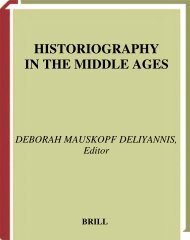Medieval Sexuality: A Casebook - Julian Emperor
Medieval Sexuality: A Casebook - Julian Emperor
Medieval Sexuality: A Casebook - Julian Emperor
Create successful ePaper yourself
Turn your PDF publications into a flip-book with our unique Google optimized e-Paper software.
4 April Harper and Caroline Proctorof articles on sex in the Middle Ages, takes us back to the desert fathers andmothers, and to their beautifully articulated and resonant personal struggleswith sexuality. Sam Riches, art and gender historian, applies notions of genderand sexuality to narratives and images of the hagiographic encounters betweensaints and monsters. Both these articles negotiate the complexities, and thecomplex manipulations, of sexual identity.April Harper is also concerned with using gender and sexuality as waysof interpreting medieval sources, particularly Old French literature. She examinesa diverse range of sources to elucidate the relationship between food and adulterouswomen, consumers and the consumed. Lynn Martin, long interested inearly modern intersections between alcohol and gender, again uses literary sources.His analysis, focused on material from the fourteenth century to the sixteenthcentury, highlights the function of sex and alcohol in male portrayals of unrulywomen. Finally in this section, Caroline Proctor looks at the way sex, and sexualmorality, featured in the careful manipulations of diet and lifestyle recommendedin late medieval medical texts. <strong>Sexuality</strong> and consumption, and their moderation,appear intimately linked in all three of these articles.In the following section, David Santiuste, whose work deals with latemedieval English political and historical identities, is also concerned with issuesof sexual morality but takes this to a higher political level, scrutinizing themotivations behind Richard III’s Proclamation for the Reform of Morals. Sexualbehavior, it seems, could play a central role in the political rhetoric of medievalpower struggles. Philip Crispin looks at the political hierarchy reversed. His workon late medieval French theater is channeled here into a consideration of the rolesexuality played in the festive drama of the clerks of the Parlement de Paris. Hesuggests that even in this world upside-down, notions of sexuality, and particularlyfemale sexuality, remained conservative.The final section explores the erotic and the exotic frontiers of sexuality inthe Middle Ages. Hugh Kennedy, perhaps one of the foremost experts in thehistory of the medieval Islamic world, turns his attention to a work of Al-Jå˙iΩand his sexual commentary. The debates in this work are examined as a productof the changing court, but are also compared to an earlier Greek text to illuminateearly understandings of sexual orientation and to compare Greek and Arabiccultural attitudes to homosexuality. Kim Phillips brings the collection to anend, looking at medieval travel writers and their views of the sexualities theyencountered on their travels. Her article shows how pre-colonial descriptions ofthe peoples of the East did not depend on allegations of sodomy, surprisingevidence that allows her to engage with ideas of sexuality, sodomy, colonialismand the other. Her work urges us to see what is not, as well as what is, medievalsexuality.













